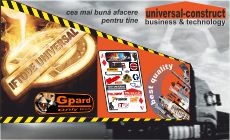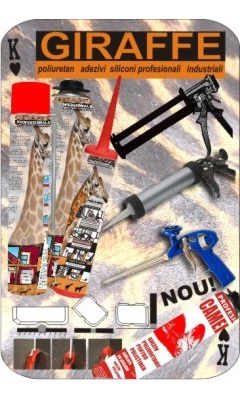Despre Milwaukee
Milwaukee Tool is an industry-leading manufacturer of heavy-duty power tools,
accessories and hand tools for professional users worldwide.
Since the company began in 1924, Milwaukee Tool has led the industry in both durability and performance. With an unwavering commitment to the trades, Milwaukee continues to lead with a focus on providing innovative, trade-specific solutions. Whether it is through their leadership in LITHIUM-ION technology, as seen in the M12™, M18™ & M28™ Systems, time-saving accessories or innovative hand tool products, Milwaukee is dedicated to delivering a steady stream of advanced solutions for the trades that offer increased productivity and unmatched durability.
To do this, Milwaukee takes the time to work side by side with real craftsman to understand the demands of a constantly changing workplace and how they can best deliver solutions that help the user work both faster and smarter. This user focus not only leads to solutions for real jobsite challenges, but fuels the disruptive innovation seen across all product lines.
Milwaukee Electric Tool is a subsidiary of Techtronic Industries Co. Ltd. (TTI), ttigroup.com.
Founded in 1985, TTI is a leading marketer, manufacturer and supplier of home improvement and floor care products, employing over 20,000 people worldwide. TTI's global brand portfolio includes Ryobi®, Milwaukee® and AEG® power tools, Homelite® and Ryobi® outdoor power equipment and Dirt Devil® and VAX® floor care appliances.
History books will forever remind us that 1918 was the year the Armistice was signed, signaling the end of World War I. Similarly, in 1918, the world of power tools changed. This is the story of how and why.
THE BEGINNING
As World War I drew to a close, Henry Ford approached a young manufacturer named A.H. Petersen with a simple product request. Petersen had been producing tools and dies for the Ford Motor Co. for a number of years. The request was for Petersen to produce a smaller, lighter, portable 1/4” capacity power drill.
Petersen seized the opportunity to provide Ford with the tool he was looking for, and created the Hole-Shooter, a 5-pound drill with a series type Westinghouse motor that could stand up against the same forces imposed on an electric drill designed for heavy work loads.
Ford enthusiastically approved of the new Hole-Shooter. Previous models of two-handed drills were heavy and cumbersome tools only the strongest mechanics could operate productively. The Hole-Shooter was the tool industry's first, lightweight, one-handed drill capable of handling heavy-duty workloads.
In 1922, A. F. Siebert joined Petersen, and the two formed the A.H. Petersen Company. In 1923, a devastating plant fire struck their facility. Unable to overcome that setback and the recession that followed, the A.H. Petersen Company closed its doors. Bought at auction in 1924, with the intention to fully develop the sales potential of the Hole-Shooter, A. F. Siebert began the Milwaukee Electric Tool Corp.
THE EARLY YEARS
During the early years, Milwaukee kept itself in business by repairing tools that were already on the market. As employees repaired and refurbished tools, they kept a constant tab on customer research – discovering what the marketplace wants, learning how it can be supplied to them at a reasonable cost, while continuing to make a profit along the way.
Company engineers spent hundreds of hours studying and analyzing competitive electric, portable power tools – what made them work, what set them apart from the competition, what components could be blended to make them better.
Continuing to look for ways to improve its product line, a series of changes and improvements were made to the Hole-Shooter, making it stronger and more durable. Inefficient bronze bushings and spur gear drives, poorly grounded cords and switches were replaced. By listening and responding to what the market wanted, the new Hole-Shooter quickly won rapid acceptance in the automotive and heavier metalworking industries.
In addition to improving its tools, Milwaukee also expanded its facilities to permit manufacture of the company's own fractional horsepower motors to meet specific speed and power requirements. The results of this customized motor were improved overload capacity, increased performance, lower maintenance and longer tool life.
SETTING THE STANDARD
Word of the new improvements quickly spread and soon, specifications for tools produced by Milwaukee rivaled the equipment standards of the United States Government.
In 1930, the company sought and achieved an acceptable equipment specification rating from the government for its new portable electric drill. Before long, Navy technical standards were being applied to the manufacture of all Milwaukee portable tools. Electric sanders, polishers, the electric hammer, and a portable hand grinder were now all manufactured according to the Navy’s specifications.
In 1935, Milwaukee introduced a lightweight 3/4” electric hammer-drill for drilling or setting anchors in concrete. Easily converted to a 3/4” drill, this tool quickly won acceptance and was followed by a shorter, lighter and more specialized unit designed exclusively for precision drilling.
Since the sander/grinder is generally considered the one tool in the welding profession that gets the heaviest use, it was the growing reputation of the still-young Milwaukee company that prompted welders to look for a source that could improve on their existing line of tools. Milwaukee gladly accepted the opportunity to prove itself. Designers knew that the new sander/grinder had to be easy to handle, yet capable of taking brutal punishment in the field. The result was a 15-pound, single-horsepower model that was perfectly balanced.
WORLD WAR II
World War II and the tremendous use of portable power tools in the armed forces marked the real turn around for the tool business and Milwaukee. Hole-Shooters were used extensively in the manufacture of airplanes and many new product ideas were developed during that period.
Milwaukee met the challenge by building more powerful motors, mounting shafts on ball and roller bearings and through more dynamic balancing. Every individual who helped build Milwaukee Hole-Shooters during World War II played a vital role in the winning of the war. The Navy liked the idea of their standard approved specifications being followed and ordered generously from Milwaukee.
MEETING A NEED FOR PRODUCTS
Milwaukee's success accelerated in the post-war years as development of new tools to match the needs of professionals continued. In 1949, the line of sander/grinders was updated with the addition of a spring clutch that prevented backlash and offered a smoother running tool. The feature proved to be so popular that it was later added to the circular saw line. And, as the new decade approached, Milwaukee engineers, always looking to improve their products, introduced a die-cast housing rather than heavy sand castings, and a new 1 1/2-hp model with dust-proof switches.
That same year, Milwaukee introduced the industry's first 1/2” right-angle drill, designed to allow plumbers and electricians to work in tight quarters and with the power to drill 2 9/16” diameter holes in wood with a self-feed bit and 1/2” diameter holes in steel. Later, a reversing motor was added to increase the tool's versatility.
In 1951, Milwaukee produced an unparalleled new tool – the Sawzall® Reciprocating Saw. As the first portable hacksaw incorporating a reciprocating mechanism, it had just three moving parts and was designed to withstand daily abuse and still provide a 3/4” stroke ideal for sawing and roughing out. To meet the demands of a market looking for versatility in all types of materials, Milwaukee added a full line of blades to the Sawzall lineup.
Both the right-angle drill and the Sawzall Reciprocating Saw revolutionized the power tool industry, firmly establishing the Milwaukee tradition of designing tools that helped professionals meet the challenges of their jobs more efficiently.
The 1960s and 1970s were good years for Milwaukee, and resulted in expansion of both manufacturing facilities and product lines. In 1965, the company moved from its State Street location, in the City of Milwaukee, to its modern 212,000-square-foot manufacturing and office facility in Brookfield, Wis.
In 1974, the desire to be closer to an important and emerging market in the Southeast resulted in the building of Milwaukee's first facility outside of Wisconsin - a 60,000-square-foot manufacturing plant in Jackson, Miss. With Amstar's acquisition of Milwaukee in 1976, the company expanded further adding a manufacturing plant in Blytheville, Ark., supported by a large distribution center in Olive Branch, Miss. In 1995 an additional 75,000-square-foot manufacturing plant was added in Kosciusko, Miss. Milwaukee opened a 100,000-square-foot manufacturing plant in Greenwood, Miss. in 2002 and later that year completed a 50,000-square-foot expansion for increased production capabilities.
Along with new manufacturing and distribution facilities, the 1970s brought with them the emergence of new products including the Hole Hawg®, the first drill designed specifically for large hole drilling between studs and joists in residential construction. During the 1970s, Milwaukee also introduced the first 1/2” professional pistol drill – the Magnum Hole-Shooter®, with the Quik-Lok® cord and easily changeable brushes. In 1979, Milwaukee manufactured the first U.S.-made 4 1/2” angle grinder.
In the years that followed, the Sawzall Reciprocating Saw was upgraded to include variable speeds and a Quik-Lok® cord. In 1991, it was made even better with the introduction of the Super Sawzall Reciprocating Saw. Now holding five patents, the Super Sawzall Reciprocating Saw underwent two years of testing before going to market. It includes a counter balance mechanism and a gear protecting clutch that set a new standard as the world's most vibration-free, fast-cutting, reciprocating saw.
Milwaukee's tradition of quality continued through the 1990s with introductions of a new line of miter saws and expanded cordless offerings. Other products introduced in the late 1990s include the 10-amp, 0-3,200 spm Super Sawzall Reciprocating Saw and an 18-volt "contractor cordless" line of tools, featuring a cordless Sawzall Reciprocating Saw, Rotary Hammer, 1/2” D-handle and Right-Angle Drill, Hammer-Drill, Driver/Drill, Impact Wrench, Circular Saw, Metal Cutting Circular Saw, Hatchet Reciprocating Saw, and Job Site Radio, all using the same battery and charger system.
Most recently, Milwaukee has led the way in power tool innovation through the use and development of new technologies such as being the first to use lithium-ion batteries in its line of cordless tools, and in 2008 developed Ice-Hardened strengthening technology for its accessories.
In keeping with its mission of producing only high-quality heavy-duty products for professional users, Milwaukee branched into the hand tool market in 2008 by purchasing the Stiletto Tool Company, the leading manufacturer of professional titanium hammers and other hand tools, stiletto.
BUILDING UPON A TRADITION OF SUCCESS
Milwaukee Electric Tool currently employs over 1,000 people globally. Since its inception, the company continues to set industry standards, targeting professional tool users of all types with a product line that includes more than 500 tools and over 3,500 accessories. And, as in the early years, the commitment to quality remains steadfast, although the way that quality is ensured has changed drastically. Quality is designed in, using state-of-the-art technologies and sophisticated manufacturing techniques.
As Milwaukee moved into the 21st century, the company adapted to the ever-changing needs of power tool users by placing a renewed emphasis on rapid new product development. Because of its presence in the U.S. and overseas, Milwaukee has 24-hour development capabilities. To effectively implement this around-the-clock capability Milwaukee has placed a major focus in seven areas: Innovative quality, speed to market, commitment to research and development, customer insight, employee development, developing leadership within the company, development of a world-class training facility and hands on training.
In 2008 Milwaukee enhanced its commitment to training by developing a 15,000-square-foot training facility (Pudwill Leadership Center). The facility, located within Milwaukee’s corporate headquarters in Brookfield, Wis., can host product application, sales skills and leadership skills training. The facility is designed to train Milwaukee employees, distributor partners and professional end users from all over the world.
NEW OWNERSHIP AND GROWTH
Milwaukee Electric Tool was acquired by Techtronic Industries Co. Ltd. (TTI) in 2005, www.ttigroup.com
Founded in 1985, TTI is a leading marketer, manufacturer and supplier of home improvement and floor care products, employing over 20,000 people worldwide. TTI's global brand portfolio includes Ryobi®, Milwaukee Electric Tool® and AEG® power tools, Homelite® and Ryobi® outdoor power equipment and Dirt Devil® and VAX® floor care appliances. The acquisition took advantage of TTI and Milwaukee’s marketing and distribution networks and enhanced Milwaukee’s ability to expand its markets and product portfolio worldwide.
MILWAUKEE DIFFERENCE
Milwaukee Electric Tool has focused on one vision: Produce the best line of innovative heavy-duty electric power tools available for professional users.
With more than 500 models and 3,500-plus accessories, the Milwaukee line is designed by professionals for professionals. That's why the Milwaukee logo has never been found on consumer-grade power tools…and never will.
TOOLS WITH A PURPOSE
Milwaukee Electric Tool develops heavy-duty professional products with rigorous attention to:
- Commitment to professional power tool users by incorporating their insight and feedback to fully develop research that results in producing tools that enhances their productivity.
- Benchmarking so Milwaukee prototypes offer the "best-in-class" product ranking.
- Demanding laboratory and in-field user testing to assure product/job match. Milwaukee engineers don't just design a tool . . . they design a tool to do the job better.
HEAVY DUTY CUSTOMER SUPPORT
Part of the heavy-duty commitment of Milwaukee Electric Tool is availability and convenience. The complete line of power tools is available through quality tool distributors everywhere. Availability is only one part of the heavy-duty customer support commitment. If service is ever needed, you'll easily find it through authorised service stations and company-operated service branches worldwide.
COMMITMENT
Milwaukee Electric Tool and its employees are totally committed to support the professional tool user. If nothing but innovative heavy-duty power tools will give the durability and reliability you need, demand Milwaukee…providing professional power tools made by professionals, for professionals since 1924.
INNOVATION & PRODUCT DEVELOPMENT
Since its founding in 1924, Milwaukee Electric Tool has been an industry leader in power tool innovation. Just some of the innovative products from Milwaukee include the Tilt-Lok, the world’s first adjustable handle circular saw; the BodyGrip® Router with an exclusive tactile grip and adjustable handstrap, and the Sawzall - the Hatchet® Reciprocating Saw with 6-position rotatable handle.
The Milwaukee V28™ lithium-ion cordless tool system, was yet another new revolution in the power tool industry. As the first to incorporate lithium-ion battery technology in its cordless power tools, Milwaukee’s V28 battery delivers up to twice the run-time and 40-50% more power than an 18-volt NiCd battery of the same weight.
More recently Milwaukee innovation continued with the M12 and M18 cordless system of power tools which are precisely designed to deliver the power, speed, torque and durability necessary for diverse professional applications.
From customer input research, CAD design, in-house extensive life and reliability testing, rapid prototype development and field testing to final product launch, Milwaukee prides itself on its reputation for delivering innovative, quality power tools and accessories.
In keeping with its mission of producing only high-quality heavy-duty products for professional users, Milwaukee branched into the hand tool market in 2007 by purchasing the Stiletto Tool Company, the leading manufacturer of innovative professional titanium hammers and other hand tools, stiletto.com.
- Noutati 2019 (100%)
Pagina precedentă: Milwaukee UPGRADE.OUTWORK.OUTLAST.
Pagina următoare: Garantii Milwaukee Romania










